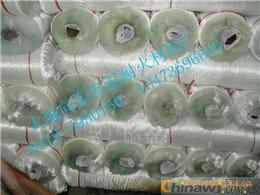Glass fiber cloth
The following is a description of various glass fiber cloths, glass fiber fabrics woven from glass fiber yarns.
(1) Glass cloth The glass cloth produced in China is divided into two types: alkali-free and medium-alkali. Most of the foreign countries are E-GLASS alkali-free glass cloth. Glass cloth is mainly used to produce various electrical insulating laminates, printed circuit boards, various vehicle bodies, storage tanks, boats, molds, and the like. Medium alkali glass cloth is mainly used for the production of coated packaging fabrics and for corrosion resistant applications. The properties of the fabric are determined by fiber properties, warp and weft density, yarn structure and texture. The warp and weft density is determined by the yarn structure and texture. The warp and weft density plus the yarn structure determines the physical properties of the fabric, such as weight, thickness and breaking strength. There are five basic textures: plain plan (similar to gingham), twill twill (generally +-45 degrees), satin statin (similar to unidirectional cloth), ribbed leno (glass fiber mesh main weave) and Mat matts (similar to Oxford cloth).
(2) The glass fiber ribbon is divided into a woven side belt (light side belt) and a non-woven side belt (burr belt). The main weave is plain weave. Alkali-free glass fiber ribbons are commonly used in the manufacture of high-strength, dielectric-good electrical equipment components.
(3) Glass fiber unidirectional fabric, unidirectional fabric, wherein the single warp fabric is a four-striped or long-satin satin fabric woven from coarse warp yarns and fine weft yarns, which is characterized by a warp yarn main direction of 0 degrees. Has high strength. There are also glass fiber single weft fabrics, which are warp-knitted and woven. They are characterized by coarse weft, fine warp and glass fiber yarns which are fed in the weft direction and have high strength in the 90 degree latitude.
(4) Glass fiber three-dimensional fabric The three-dimensional fabric is a relatively flat fabric, and its structural features are developed from one-dimensional two-dimensional to three-dimensional, so that the composite material with the reinforcement has good integrity and profiling, greatly improving The interlaminar shear strength and damage tolerance of the composite. It has been developed with the special needs of aerospace, aviation, weapons, ships and other departments, and its application has been extended to the automotive, sports equipment, medical equipment and other departments. There are five main categories: woven three-dimensional fabrics, knitted three-dimensional fabrics, orthogonal and non-orthogonal nonwoven three-dimensional fabrics, three-dimensional woven fabrics, and other forms of three-dimensional fabrics. The shape of the three-dimensional fabric has a block shape, a column shape, a tubular shape, a hollow truncated cone shape, and a variable thickness profile cross section.
(5) Glass fiber shaped fabric The shape of the shaped fabric is very similar to the shape of the article to be reinforced, and must be woven on a dedicated loom. Shaped fabrics of symmetrical shape are: round caps, cones, caps, dumbbell-shaped fabrics, etc., and can also be made into asymmetrical shapes such as boxes and hulls.
(6) Glass fiber core fabric The core fabric is a fabric composed of two parallel fabrics connected by longitudinal vertical strips, and the cross-sectional shape thereof may be a triangular shape, a rectangular shape, or a honeycomb structure.
(7) Fiberglass stitchbonded fabrics, also known as knitted or woven felts, differ from ordinary fabrics and felts of the usual sense. The most typical stitchbonded fabric is a layer of warp yarns which are overlapped with a layer of weft yarns, and the warp yarns and the weft yarns are woven together into a fabric by stitching. The advantages of the stitchbonded fabric are as follows: 1. It can increase the ultimate tensile strength of the FRP laminate, the delamination strength under the tension and the flexural strength; 2 reduce the weight of the FRP product; 3 smooth the surface of the FRP; 4 simplify Hand paste operation to improve labor productivity. This reinforcing material can replace continuous strand mat in pultrusion FRP and RTM, and can also replace gingham in the production of centrifugal glass tubing.

SPCP120
Solid-phase synthesis, as the key process in the production of Bio-pharmaceuticals, is widely used for the synthesis of peptides, deoxyribonucleic acid (DNA) and so on. The synthesis method is to bound the functional group such as methyl, hydroxymethyl on a bead, which primiarly is polystyrene microsphere with low crosslink.
excellent batch to batch reproducibility and consistency:The beads are strictly controlled by unique technology and verified SOP from the first step; that can guarantee the consistency of the particle size and crosslink degree to achieve the excellent batch to batch reproducibility in the scale production.
Resins For Solid Phase Synthesis SPCP120
Resins For Solid Phase Synthesis Spcp120,Alternative For Mitsubishi Sp20Ss,Replace C18 Silica Gel,Spcp120 Solid-Phase Synthetic Resin
Nanjing Genshine Bio-technology Co., Ltd , http://www.genshine-bio.com